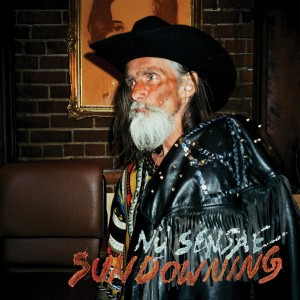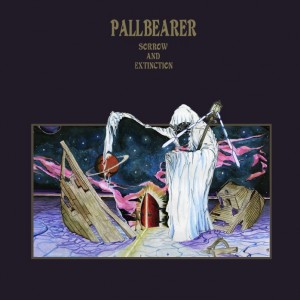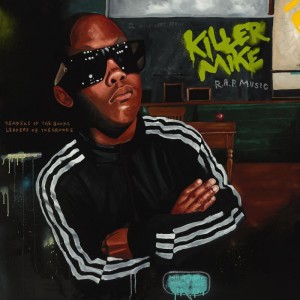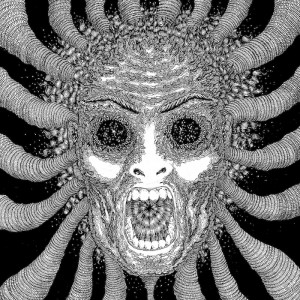
30.
DIIV
Oshin
[Captured Tracks]
Oshin is the type of album that on first impressions seems simple, but try pinning a label to it and you’ll find reasons to amend it instantly. The impressionable way they spell their name, DIIV, presented in all caps, combined with the cultish imagery that adorns the cover could easily give you the impression they’re some kind of goth band; the quicksilver guitars delivered at breakneck speed could file them under punk; the way Cole Smith’s vocals are warbled and embedded down amongst the guitars ties it to dream pop; the downright catchiness of the vocal and musical hooks puts it on them on the same page as straightforward indie rock acts. In truth, all and none of these tags apply to DIIV, whose music was cooked up and birthed by Smith when he bedded down in a lonesome, waterless Brooklyn studio with a bunch of records and instruments and set about expressing himself honestly through this music. The result is an album with a clear vision with a mapped-out start, middle and ending, peaks and troughs that carry you throughout. Ultimately this results in a piece of work that is bigger than the sum of its parts, gently but purposefully moving you right where it wants you, just like the ocean of its title.
– Rob Hakimian

29.
Holy Other
Held
[Tri Angle]
Holy Other’s 2011 Tri Angle debut, With U, showed staggering amounts of promise with its emotionally scared atmospheres and aching, heartrending melodies. At first glance, Held seems to simply build on what was accomplished with With U, but there’s something far more sophisticated and revelatory at work here. On Held, Holy Other decided to center on the emotional side of his work first and foremost and let his production tendencies follow suit instead of the other way around, sculpting his blend of soggy, bed-ridden house, garage, and hip-hop around an album length crumbling of a longterm romantic relationship. Holy Other operates like he’s constructing an untethered internal, emotional and physiological monologue, beats revving up and slowing down, a kick drum left bare to pound into a frustrated silence, a tangle of combative voices rising to a pitch. It could be the final spat between lovers before deciding they’re better off apart or the entire doomed relationship itself. The truly jaw dropping thing, however, is Holy Other’s ability to capture the chaos of conflicting emotions requisite to such a falling out in all their intimacy and specificity. It’s not a linear journey and it’s not easy one either, but Holy Other makes it.
– Will Ryan

28.
Nü Sensae
Sundowning
[Suicide Squeeze]
Sundowning is a phenomenon observed within a single disease, at a certain time of day, the specificity of which surely isn’t lost on Vancouverite trio Andrea Lukic, Daniel Pitout and newly-recruited noise vet Brody McKnight, who comprise Nü Sensae. They have seized the fear and terror that one can easily imagine might accompany dementia, and packaged into a salient blitzkrieg of noise, sound and fury. The manic adolescence of tracks like “Dust” and “Orange Roses” hit like a kiloton of bricks and with the intensity of a lucid dream. The relentless barrage of Pitout’s drumming, which oftentimes sounds like he has grown a third arm, would make for a pretty gripping listen on its own. Coupled with Lukic’s throat-tearing shriek and some sharp guitar work, it’s a fearless and fearsome entry into any punk’s playbook. So when you turn the lights on and the walls become monsters, you can thank Nü Sensae for conjuring the horror so vividly.
– Brendan Frank

27.
Merchandise
Children of Desire
[Katorga Works]
Maybe White Lung’s Mish Way said it best in an open letter to Merchandise’s Carson Cox: “We are the recycled generation. We are the regurgitation of our influences and we all sound like those before us, but you guys are paying homage without actually paying homage.” This is especially true of punk; reviews of which are too often reduced to a game of Name That Influence while ignoring the vitality of the music. But Children Of Desire, for all the Joy Division comparisons, is less homage than informed statement. Songs like “Time” and BPM Song Of The Year-contender “Become What You Are” have a serious attitude about them that is distinctly Merchandise, and the way they’re crafted speaks for a band that has strong ideas for what it wants to do and knows how to execute them.
To those in favor of dismissing this album because of its sound, I’d like to offer a reminder: another album criticized for sounding too much like Joy Division turned 10 this year. It still seems to be doing pretty well.
– David Wolfson

26.
Godspeed You! Black Emperor
Allelujah! Don’t Bend! Ascend!
[Constellation]
Suddenly, ten years later. That’s actually a pat summary of Godspeed’s sound; it’s at once a visceral rush of riffs and noise and dynamics that shift and dart like barracudas (with the occasional world-ending monologue thrown in for good measure) as well as something vast, something epic, something almost too grand to be viewed with immediacy and that stretches towards the infinity after which they named their debut album. And it’s like they never left. The drums sound as proud and as clamorous as ever, veritable timpanis in this band’s orchestra. The guitar work is as fresh and multifaceted as it was last decade. Soaring strings and even a glockenspiel round out the post-rock extravagance of “We Drift Like Worried Fire.” Only these guys don’t sound worried at all. 53 minutes is pretty lean for a Godspeed record, but it underscores their newfound confidence; their passion shines through as brightly (or, you know, darkly) as ever and with unprecedented efficiency.
– Josh Becker

25.
Beach House
Bloom
[Sub Pop / Bella Union]
Few things in the indie music community disturbed me more this year than widespread dismissal of Bloom as Teen Dream II. In Alex Scally’s own words: “What the fuck is that? Sometimes I feel like people aren’t listening to our songs, they’re just listening to the sound.” Indeed: Bloom is an album all about songs, and it boasts exactly 10 great ones. Even more grand and ambitious than its predecessor, Bloom evokes a wider range of emotions and its soundscapes seem to cover a greater expanse of the sky – songs like “Wishes” and the crystalline “Lazuli” are the biggest Beach House has ever sounded. At the same time, songs like “The Hours,” with its references to the classic pop of the 60s, and the band’s new high watermark, “Myth,” are the best that the band has ever penned. More than anything, Victoria Legrand and Alex Scally sound at the top of their game, the performances captured on the recordings shining through the shimmering effects and swaths of reverb that younger bands continue to hide behind. In the context of 2012, after two years of anticipation and waiting, maybe Bloom is just too familiar for some music fans to recognize the leaps that Beach House continue to make with each record. But, in a few years and with the gift of hindsight, those people will be proven wrong.
– Ryan Stanley

24.
Pallbearer
Sorrow and Extinction
[Profound Lore]
While Beats Per Minute is admittedly not the definitive source when it comes to the ins and outs of modern day metal, we know heart and power when we hear it. Pallbearer’s debut Sorrow and Extinction comes as nothing but a pleasant surprise for metal fans and general appreciators of rock. As accessible of a metal album it is, it does not compromise in power or aptitude towards the genre’s increasingly rich history — it embraces and builds upon that which has already existed. There is an overwhelming familiarity to their sound, harkening back to the golden age of metal, but they move it in a direction of modern doom metal. Their band name even suggests the mourning of a time long forgotten and dead — while Sorrow and Extinction feels nostalgic, it remains a simple and proper send-off to the metal bands that effectively forged a loyal sub-culture. In their mystical lyricism, their love for the past is undeniable: “In the presence of ancients, beckoning to me, and I fear to be their conduit and lose myself in the shadow.” Sorrow and Extinction captures that rush of the groups that built metal, but they are certainly paving their own way for the future.
– Andrew Halverson

23.
Killer Mike
R.A.P. Music
[Williams Street]
Despite a sizable body of critically acclaimed work, Killer Mike still seems to be relegated to the fairly prevalent “featured guest verse” role at this point in his career. But thanks to producer El-P and Mike’s latest record R.A.P. Music that should all be changing. Never one to shy away from controversy, R.A.P. Music will only add fuel to the fire for those who wrongly dismiss him as an empty politico talking-head, as songs like “Reagan” (with its ending line “I’m glad Reagan dead”) and “Big Beast” are venomous critiques of governments who lie and treat their people disproportionately different. The songs here not only take jabs at race inequality, though that does figure heavily in his lyrics, but class warfare and politics are also front and center in his sites. If for nothing else, the album would be remembered for the bile spewing rhetoric that Mike has pretty much perfected at this point but the production, courtesy of El-P, elevates R.A.P. Music to the level of revolutionary and reactionary art. Devoid of any extraneous fat, the songs here feel alive and crackle with a razor wit, and in a year when the majority of hip-hop felt bloated and self-satisfied, Killer Mike and El-P have delivered an aural H-bomb directly into the cerebral cortex of their fans.
– Joshua Pickard

22.
Ty Segall Band
Slaughterhouse
[In The Red]
Ty Segall has had a very busy year. He collaborated with White Fence on Hair, released another amazing solo record called Twins, and pulled together an amazing set of touring and studio musicians for a record under the Ty Segall Band moniker called Slaughterhouse. All these records were filled with enough undeniable hooks, crunch-laden melodies, and Segall’s trademark howling vocals to connect with even the most jaded indie rock fan. But it’s on Slaughterhouse that Segall and his band are able to successfully condense the past 20 years of garage and indie rock into a tightly wound piece of thunderous rock art.
From the menacing distortion that covers opening track “Death” to the fuzzed out fuck-you attitude of their fiery cover of Bo Diddley’s “Diddy Wah Diddy,” the band never slows down and never seems to take a breath. Even the fractured noise rock of “Fuzz War” seems astonishingly vital as the band tears through it with a fierce determination not heard on any other rock record this year. Jumping between high speed garage rockers (“Oh Mary”) and sludgy swamp stompers (“Wave Goodbye”), Slaughterhouse manages to combine everything we’ve come to know about Segall with a handful of new tricks and positions him as one of the most successfully inadvertent rock preservationists around and one hell of an amazing ax man.
– Joshua Pickard

21.
Purity Ring
Shrines
[4AD]
Purity Ring has made for one of the more compelling will they/won’t they? narratives of the past few years. With Shrines, the Edmonton duo proved that they could multiply the success of “Ungirthed” with panache to spare, and quickly hushed up those who equated that 18-month gap between the two with a dearth of ideas. Megan James brings a gruesome delicacy to the proceedings in a dazzling lyrical effort, while Corin Roddick’s hiccoughing production whirls around the drain in perpetuity. The whole thing borders on fantastical at times, which is perhaps best captured in the observation that (closing track “Shuck” excepting) none of the song titles here are actual words. Even with all of its outlandish habits in tow, it’s an oddly magnificent structure.
– Brendan Frank


